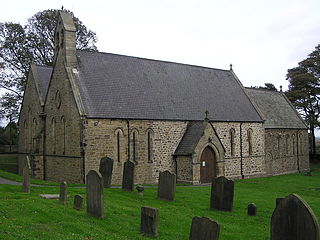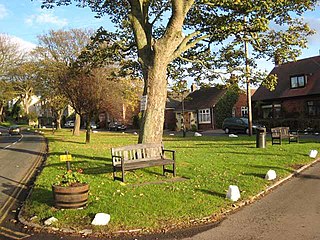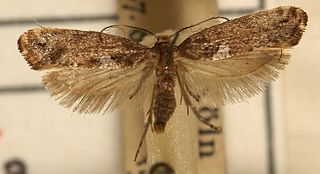
North East England is one of nine official regions of England at the first level of ITL for statistical purposes. The region has three current administrative levels below the region level in the region; combined authority, unitary authority or metropolitan district and civil parishes. They are also multiple divisions without administrative functions; ceremonial county, emergency services, built-up areas and historic county. The most populous places in the region are Newcastle upon Tyne (city), Middlesbrough, Sunderland (city), Gateshead, Darlington and Hartlepool. Durham also has city status.

Durham, is a cathedral city and civil parish on the River Wear, County Durham, England. It is an administrative centre of the County Durham District, which is a successor to the historic County Palatine of Durham.

Durham is a city in the U.S. state of North Carolina and the county seat of Durham County. Small portions of the city limits extend into Orange County and Wake County. With a population of 283,506 in the 2020 census, Durham is the 4th-most populous city in North Carolina, and the 74th-most populous city in the United States. The city is located in the east-central part of the Piedmont region along the Eno River. Durham is the core of the four-county Durham-Chapel Hill Metropolitan Area, which had a population of 649,903 at the 2020 census. The Office of Management and Budget also includes Durham as a part of the Raleigh-Durham-Cary Combined Statistical Area, commonly known as the Research Triangle, which had a population of 2,043,867 at the 2020 census.

The Cathedral Church of Christ, Blessed Mary the Virgin and St Cuthbert of Durham, commonly known as Durham Cathedral and home of the Shrine of St Cuthbert, is a cathedral in the city of Durham, County Durham, England. It is the seat of the Bishop of Durham, the fourth-ranked bishop in the Church of England hierarchy.

Chester-le-Street, is a market town and civil parish in County Durham, England, around 6 miles (9.7 km) north of Durham and also close to Sunderland and Newcastle upon Tyne. It is located on the River Wear, which runs out to sea at Sunderland to the east. The town holds markets on Tuesdays, Fridays and Saturdays.

Hartlepool is a seaside and port town in County Durham, England. It is the largest settlement and administrative centre of the Borough of Hartlepool. With an estimated population of 90,123, it is the second-largest settlement in County Durham.

County Durham, officially simply Durham, is a ceremonial county in North East England. The ceremonial county was created from the historic County Palatine of Durham in 1853. In 1974, a large part of the county was lost when Gateshead, Jarrow, South Shields, Washington, Sunderland, Houghton-le-Spring, Hetton-le-Hole and other surrounding villages and towns near these settlements were moved into the Tyne and Wear county forming the modern boroughs of Gateshead, South Tyneside and Sunderland. In 1996, the county gained part of the abolished ceremonial county of Cleveland and also saw Darlington along with Stockton-on-Tees and Hartlepool become unitary authorities but remaining part of the county for ceremonial purposes. The county town is the city of Durham.

Staindrop is a village and civil parish in County Durham, England. It is situated approximately 6 miles (9.7 km) north east of Barnard Castle, on the A688 road. According to the 2011 UK Census the population was 1,310, this includes the hamlets of Cleatlam and Killerby.

Piercebridge is a village and civil parish in the borough of Darlington and the ceremonial county of Durham, England. The population of the civil parish as of the 2011 census was 113. It is situated a few miles west of the town of Darlington. It is on the site of a Roman fort of AD 260–270, which was built at the point where Dere Street crossed the River Tees. Part of the fort is under the village green. The village is sited where the York-Newstead Roman road known as Dere Street crosses the River Tees.

Cockfield is a village on the edge of Teesdale, County Durham, England. It is situated 8 miles to the south-west of Bishop Auckland, 15 miles (24 km) north-west of Darlington and 40 miles (64 km) south-west of Newcastle upon Tyne. Remains found on Cockfield Fell suggest there was a settlement in the area during the Iron Age. The parish church, dedicated to St Mary the Virgin, probably dates from the late 12th century.
Murton is a village in County Durham, England. Lying eight miles (13 km) east of the city of Durham and six miles (9.7 km) south of Sunderland, it has a population of 4,534, increasing to 7,676 at the 2011 Census.

Middleton-in-Teesdale is a market town in County Durham, in England. It is situated on the north side of Teesdale between Eggleston and Newbiggin, a few miles to the north-west of Barnard Castle. The settlement is surrounded by the North Pennines Area of Outstanding Natural Beauty (AONB).

Elwick is a village and civil parish in the borough of Hartlepool and the ceremonial county of County Durham, in England. It is situated near the A19 road to the west of Hartlepool. Hartlepool Borough Council governs Elwick. As Elwick is only a small parish it is not able to run itself as its own district. It does have a Parish Council. Elwick was known as a township until 1866, but then was changed to a civil parish status.
Redmarshall is a village and civil parish in the borough of Stockton-on-Tees and ceremonial county of County Durham, England. The population as of the 2011 census was 287. Redmarshall is situated to the west of Stockton-on-Tees, just north of the A66 road which is one of the main trunk routes through Teesside. It is home to the Church of Saint Cuthbert and a pub called The Ship. It has a green in the centre and roads such as Church Lane, Coniston Crescent and Windermere Avenue, named after waters in the Lake District. Ferguson Way is the newest addition to the village. A small wood is a short way out of the village and down a bank past Ferguson Way. There is a new housing estate called the langtons being built on the old remains of the mains care home.

The Acrolepiidae are a family of moths known as false diamondback moths. In modern classifications, they are often treated as a subfamily (Acrolepiinae) of the family Glyphipterigidae.

The County Palatine of Durham and Sadberge, commonly referred to as County Durham or simply Durham, is a historic county in Northern England. Until 1889, it was controlled by powers granted under the Bishopric of Durham. The county and Northumberland are also traditionally known together as Northumbria.

Piercebridge Roman Fort is a scheduled ancient monument situated in the village of Piercebridge on the banks of the River Tees in modern-day County Durham, England. There were Romans here from about AD 70 until at least the early 5th century. There was an associated vicus and bath house at Piercebridge, and another vicus and a villa south of the river at Cliffe. The Victorians used carved stones from this site when they built St Mary's church at Gainford. Part of the site is under Piercebridge village green.

The Bishop of Durham is the Anglican bishop responsible for the Diocese of Durham in the Province of York. The diocese is one of the oldest in England and its bishop is a member of the House of Lords. Paul Butler has been the Bishop of Durham since his election was confirmed at York Minster on 20 January 2014. The previous bishop was Justin Welby, now Archbishop of Canterbury. The bishop is one of two who escort the sovereign at the coronation.

Acrolepiopsis is a genus of moths in the family Acrolepiidae.

Rokeby is a civil parish about 2.5 miles from Barnard Castle, in the County Durham district, in the ceremonial county of Durham, England. The parish includes the hamlet of Greta Bridge. In 2011 the parish had a population of 158. The parish touches Barningham, Boldron, Bowes, Brignall, Egglestone Abbey, Westwick, Whorlton and Wycliffe with Thorpe. The A66 runs through the area. Rokeby shares a parish council with Brignall and Egglestone Abbey called "Rokeby, Brignall & Egglestone Abbey Parish Council".

















